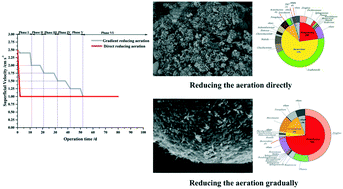Gradient reduced aeration in an enhanced aerobic granular sludge process optimizes the dominant microbial community and its function†
Abstract
The laboratory-scale aerobic sludge process was used to treat municipal sewage using a novel energy-saving aeration strategy. For comparison, two strategies of regulation (reducing the aeration directly and reducing the aeration gradually) were operated in parallel. Results showed that using an operation strategy with reduced aeration during the famine period led to a significant reduction of energy consumption (p < 0.01). Much of the aerobic sludge was washed out and granular sludge disintegrated irreversibly when the direct reduction of aeration was applied; the MLSS dropped gradually from 6.33 g L−1 to 1.94 g L−1 and the SVI reached 325 mL g−1. At the same time, the zeta potential and sludge yield rose from −17.3 mV and 1.13 kg MLSS per kg COD to −20.7 mV and 1.96 kg MLSS per kg COD, respectively. The removal efficiency of NH4+-N, TN and COD decreased to 61%, 48% and 82%, respectively. Leadbetterella spp., which belongs to the phylum Sphingobacteria, became the dominant microorganism in the bioreactor. By contrast, when the gradient reduced aeration strategy was applied, Shannon diversity indices increased significantly (p < 0.01) and the aerobic granular structure remained stable, revealing that the richness and diversity of the aerobic sludge were retained. FISH results revealed that the enrichment of functional microorganisms such as Zoogloea spp. for EPS secretion enriched in the inner part of the granular sludge. Results of 2-DE demonstrated that four extracellular proteins PPIase, pyrophosphate phosphohydrolase, OprF and OMP, which can secrete EPS, were enriched in the stable granules under the condition of gradient reduced aeration. Therefore, a scientific method to regulate the structural stability of the aerobic granular sludge was achieved in this study.



 Please wait while we load your content...
Please wait while we load your content...